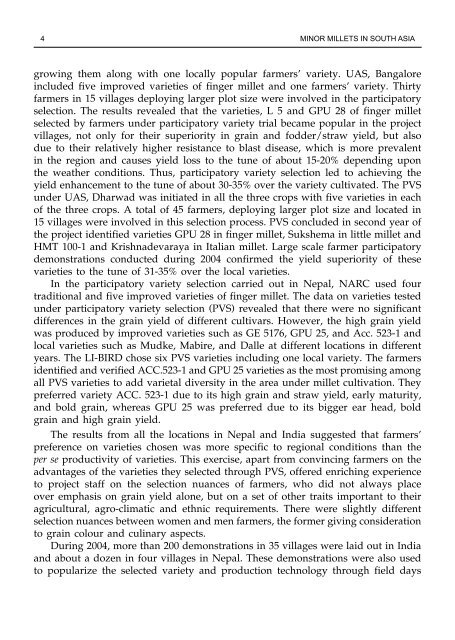Minor millets in South Asia: learnings from IFAD-NUS project in India ...
Minor millets in South Asia: learnings from IFAD-NUS project in India ...
Minor millets in South Asia: learnings from IFAD-NUS project in India ...
You also want an ePaper? Increase the reach of your titles
YUMPU automatically turns print PDFs into web optimized ePapers that Google loves.
4 <strong>M<strong>in</strong>or</strong> Millets <strong>in</strong> south AsiA<br />
grow<strong>in</strong>g them along with one locally popular farmers’ variety. UAS, Bangalore<br />
<strong>in</strong>cluded five improved varieties of f<strong>in</strong>ger millet and one farmers’ variety. Thirty<br />
farmers <strong>in</strong> 15 villages deploy<strong>in</strong>g larger plot size were <strong>in</strong>volved <strong>in</strong> the participatory<br />
selection. The results revealed that the varieties, L 5 and GPU 28 of f<strong>in</strong>ger millet<br />
selected by farmers under participatory variety trial became popular <strong>in</strong> the <strong>project</strong><br />
villages, not only for their superiority <strong>in</strong> gra<strong>in</strong> and fodder/straw yield, but also<br />
due to their relatively higher resistance to blast disease, which is more prevalent<br />
<strong>in</strong> the region and causes yield loss to the tune of about 15-20% depend<strong>in</strong>g upon<br />
the weather conditions. Thus, participatory variety selection led to achiev<strong>in</strong>g the<br />
yield enhancement to the tune of about 30-35% over the variety cultivated. The PVS<br />
under UAS, Dharwad was <strong>in</strong>itiated <strong>in</strong> all the three crops with five varieties <strong>in</strong> each<br />
of the three crops. A total of 45 farmers, deploy<strong>in</strong>g larger plot size and located <strong>in</strong><br />
15 villages were <strong>in</strong>volved <strong>in</strong> this selection process. PVS concluded <strong>in</strong> second year of<br />
the <strong>project</strong> identified varieties GPU 28 <strong>in</strong> f<strong>in</strong>ger millet, Sukshema <strong>in</strong> little millet and<br />
HMT 100-1 and Krishnadevaraya <strong>in</strong> Italian millet. Large scale farmer participatory<br />
demonstrations conducted dur<strong>in</strong>g 2004 confirmed the yield superiority of these<br />
varieties to the tune of 31-35% over the local varieties.<br />
In the participatory variety selection carried out <strong>in</strong> Nepal, NARC used four<br />
traditional and five improved varieties of f<strong>in</strong>ger millet. The data on varieties tested<br />
under participatory variety selection (PVS) revealed that there were no significant<br />
differences <strong>in</strong> the gra<strong>in</strong> yield of different cultivars. However, the high gra<strong>in</strong> yield<br />
was produced by improved varieties such as GE 5176, GPU 25, and Acc. 523-1 and<br />
local varieties such as Mudke, Mabire, and Dalle at different locations <strong>in</strong> different<br />
years. The LI-BIRD chose six PVS varieties <strong>in</strong>clud<strong>in</strong>g one local variety. The farmers<br />
identified and verified ACC.523-1 and GPU 25 varieties as the most promis<strong>in</strong>g among<br />
all PVS varieties to add varietal diversity <strong>in</strong> the area under millet cultivation. They<br />
preferred variety ACC. 523-1 due to its high gra<strong>in</strong> and straw yield, early maturity,<br />
and bold gra<strong>in</strong>, whereas GPU 25 was preferred due to its bigger ear head, bold<br />
gra<strong>in</strong> and high gra<strong>in</strong> yield.<br />
The results <strong>from</strong> all the locations <strong>in</strong> Nepal and <strong>India</strong> suggested that farmers’<br />
preference on varieties chosen was more specific to regional conditions than the<br />
per se productivity of varieties. This exercise, apart <strong>from</strong> conv<strong>in</strong>c<strong>in</strong>g farmers on the<br />
advantages of the varieties they selected through PVS, offered enrich<strong>in</strong>g experience<br />
to <strong>project</strong> staff on the selection nuances of farmers, who did not always place<br />
over emphasis on gra<strong>in</strong> yield alone, but on a set of other traits important to their<br />
agricultural, agro-climatic and ethnic requirements. There were slightly different<br />
selection nuances between women and men farmers, the former giv<strong>in</strong>g consideration<br />
to gra<strong>in</strong> colour and cul<strong>in</strong>ary aspects.<br />
Dur<strong>in</strong>g 2004, more than 200 demonstrations <strong>in</strong> 35 villages were laid out <strong>in</strong> <strong>India</strong><br />
and about a dozen <strong>in</strong> four villages <strong>in</strong> Nepal. These demonstrations were also used<br />
to popularize the selected variety and production technology through field days

















